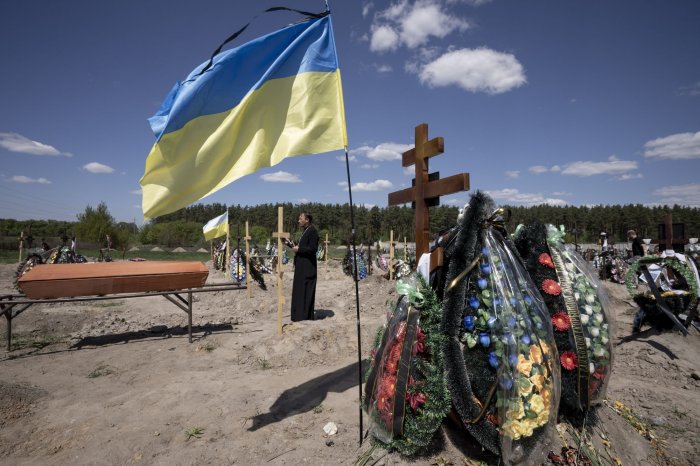Chairman of the Joint Chiefs of Staff Gen. Mark Milley said this week the "global international security order" put in place after World War II is "at stake if Russia gets away cost-free following its invasion of Ukraine." Photo by Bonnie Cash/UPI |
License Photo
As the war in Ukraine enters its third month, it is clear what the United States, NATO and other like-minded states are doing to support Kyiv in repelling the Russian invasion.
Rushing military equipment to Ukraine; imposing punishing sanctions on Russia; and isolating it are among the tools being used. But what is the strategy?
That is unclear.
U.S. President Joe Biden is flirting with the goal of enabling Ukraine "to win." But what does "winning" mean for Ukraine, Russia and NATO in particular? And what does "losing" mean for all sides?
This, too, is unclear.
U.S. Secretary of Defense Lloyd Austin's aim is to "weaken" Russia such that it will be incapable of future aggression against its neighboring states. That may be a noble, if achievable aim. It is not a strategy.
U.S. Chairman of the Joint Chiefs of Staff, Army Gen. Mark Milley, told CNN this week that the "global international security order" put in place after World War II is "at stake if Russia gets away cost-free following its invasion of Ukraine." Milley is correct. But what is the strategy to preserve the global international security order?
The fundamental problem is that at this stage, the war in Ukraine is too unpredictable on which to base any explicit strategy. The obvious alternative is to consider several options that may best suit a future that is impossible to assess with accuracy now. And of these options, one of the most important regards NATO.
NATO has rested its military strategy on "deterrence and defense" of the Euro-Atlantic Area (DDA) and the "capstone war-fighting concept" released last year. At the upcoming heads of government and state summit in Madrid in June, the alliance's Strategic Concept will be announced. However, all these important documents preceded the Ukraine War. And none anticipated the possibility that Finland and Sweden may request membership in the alliance.
With 30 states in NATO and the requirement for consensus, meaning unanimous agreement, how will or can these documents be revised to reflect the Ukrainian crisis? The alliance would seem to be well advised to put in place a major review to determine what aspects of the strategic concept, the DDA and the war-fighting concept remain relevant or need to be updated.
Is that feasible or even possible? If it were, a number of issues should be considered. The war in Ukraine has exposed the vulnerability of traditional conventional forces, including fixed and rotary wing aircraft; tanks and armored vehicles; artillery; surface ships; along with logistics to a skillful defense and imaginative and effective tactics.
One response of NATO's members so far is to pledge more defense spending. But will more spending on these conventional forces actually improve NATO's ability to deter and defend? Or are other capabilities, such as drones of all types, more handheld anti-tank and anti-air missiles, electronic warfare, deception and related systems and intelligence and surveillance enhancements more appropriate programs that will improve defense?
Similarly, if Finland joins the alliance, how will its population of about 5 million and its 800-mile border with Russia be defended? The same applies to Sweden, assuming it seeks membership. And is Article 5 sufficient?
Will the forward stationing of forces from other NATO nations, such as in the Baltics, Poland and Romania, be required? And which members are prepared to make those contributions and in what numbers?
Perhaps most importantly, Milley's concerns over the future global order must be addressed. In that regard, NATO has been and is pivotal. NATO has committed to a greater interest in Asia as China's influence and power grow, economically and militarily. But is NATO prepared to take a large role in the region? And what might that role be?
The list of these issues is too long to list here. However, the role of nuclear weapons is too important to await for a later day. Russian President Vladimir Putin and Foreign Secretary Sergey Lavrov have raised the specter of nuclear use. In Europe, while the strategic nuclear balance is more or less equal, with the West maintaining some technical advantages, Russia maintains at least a 5-to-1 numerical advantage in short-range nuclear systems.
NATO must assess that in light of Article 5. One option is to present such an overwhelming conventional capability to deny Russia a fait accompli, such as invading the Baltics. However, the lights will be burning late in Brussels as these and other crucial matters are being debated and analyzed.
Harlan Ullman is senior adviser at Washington's Atlantic Council, the prime author of "shock and awe" and author of "The Fifth Horseman and the New MAD: How Massive Attacks of Disruption Became the Looming Existential Danger to a Divided Nation and the World at Large." Follow him @harlankullman.
The views and opinions expressed in this commentary are solely those of the author.
Priest Andrii Gavalin presides over the funeral of Eugene Bogdanov, 35, in Bucha, Ukraine, on May 10. Bogdanov went missing two months ago. His wife, Natalia Bogdanova, was searching for him throughout the Kyiv and Bucha regions when his body was found at a morgue in Belaya Tserkov on May 9. Photo by Ken Cedeno/UPI |
License Photo
















